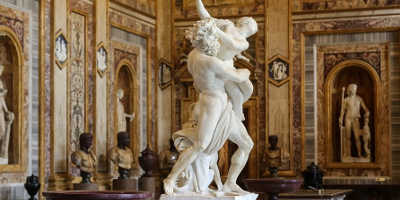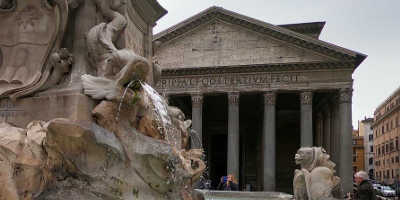Who was the Temple of Vesta Built for?
Dedicated to the goddess Vesta, the Temple of Vesta was home to the Vestal Virgins, chaste priestesses who served the Virgin Goddess by keeping her fire alight.
The Temple of Vesta is an ancient structure of the Acropolis of Tivoli. Dating back to the 1st century BC and is the most famous monument of ancient Tibur. The temple was dedicated to the goddess Vesta, the virgin goddess of hearth, home, and family and built for the Vestal Virgins to dwell in as they honour their Virgin Goddess. Selected when they’re just young girls, the Vestal Virgins swore a 30-year vow of chastity, and in turn were granted rights, privileges and power, which were otherwise unavailable to women in ancient Rome.
The Vestal Virgins
The birth of the Temple of Vesta and House of Vestals began after the King of Rome was informed that his kingdom would be protected from harm by the Goddess Vesta, the virgin goddess of hearth, home, and family. This protection would only last if the magical fire that was given by the goddess herself, was never to go out, and was to burn forever to honour the Goddess’s protection. The task of this fire was left on a college of virgin women, later known as the Vestal Virgins. The House of Vestal, including the Temple of Vesta, was built, giving these women a dwelling to proceed with the cult’s happenings. The Virgins were seen as powerful and pure women within the city as they were the protectors of Rome. Their other duties included caring for sacred objects in the shrine and inner sanctuary, preparing ritual food and officiating at public events during the yearly Vestalia (Vesta’s Feast days). They also helped prepare sacrifices and made the bread ready for feast days and other events held in Rome throughout the year. It was a very exclusive cult, only welcoming six virgins at a time, who committed to serve for thirty years. The first ten years were to learn the ways of the college, with the next ten years performing the rituals of the house and finishing their last ten years training the new recruits. They were by far the most powerful women in Rome, as they could vote, own property, and were free from their father’s control. They were also able to access places other women were banned from, such as certain events and seats in the Colosseum. Despite these perks, the cult was a strict and punishable place for the women. Breaking your vows of celibacy would have disastrous repercussions, ensuring whipping or being buried alive in the underground chambers.
The Temple of Vesta
According to Roman authors of the time, the Vestal cult was founded by Numa Pompilius, a semi-mythical Roman king who ruled around 715 to 673 BC. Six virgin priestesses were dedicated to Vesta as full time clergymen. Unlike other women, the Vestal Virgins were allowed to own property, but most resided at the Atrium of Vestae, a temple in the Roman Forum. It was one of the earliest structured located in the Forum and was a very important sanctuary in Rome. There to honour the goddess and allow the Virgins to perform their duties. All vestal temples featured a round structure, which is where the sacred hearth was, and the eternal fire burned. Once a year, in March, the fire would be re-lit and then kept burning for the next year, to ensure the fortunes of the city remained intact, if not, disaster would strike. The circular formation of the site follows the circular structure of the fire, and was perhaps influenced by the Vestal’s long tradition, which gave the people of Rome a reassuring thread of continuity. All the entrances to the temple were facing east to signify the connection between the eternal fire and the sun as sources of life. Around the Temple stood ‘The Sacred Grove,’ which was a graveyard for the priests and virgins. The temple was closed when paganism was banned in favour of Christianity, along with the descent of the Roman Empire.
Becoming a Vestal Virgin
The process whereby girls were selected to become a Vestal was known as Captio, the latin word for “capture”. This is an appropriate term as it seems the girls did not have much choice in the matter once they were selected. The girls had to be between 6 and 10 years old and born of patrician parents, and free from any mental or physically defects. Once a list of potential Vestals was drawn up by the high priest, Pontifex Maximus, the final candidates were then publicly selected by lot. Once initiated they moved to their new home in the temple, where they were trained for 10 years as initiates before becoming priestesses themselves for the next decade and then taking on the mentoring duties for their last 10 years of service. Although having more privileges than other women in society, the role of the Vestal Virgin is not that dissimilar to that of the average female citizen. Like them, the centre of Roman home life was the hearth, tended by the female head of the household for the good of her family and husband. Similarly, a Vestals duty revolved keeping the heart alight for the sake of the state. Unfortunately, all women were subject to the same suspicion, which questioned their value and chastity. Due to jealousy, malice or something of this kind, the Vestal Virgins were vulnerable to false accusations with little to defend themselves with, other than their words of innocence. This shows how important their chastity was to the cause. It even influenced how they dressed, with long white gowns to highlight their purity, a matching white veil to cover their heads, secured in place with a brooch.
The privileged position of the Vestal Virgins lasted for more than a thousand years, surviving through Rome’s changing systems of monarchy, republic, and empire. The cult would not, however, survive Christianity. In 394 AD Emperor Theodosius closed the house of Vesta forever, freeing the virgins from their obligations, but also removing their privileges. Aspects of this ancient cult, however, can still be seen in parts of early Christianity. Nuns for example, adopt a similar existence to the Vestals – chaste figures who dutifully serve one God.















